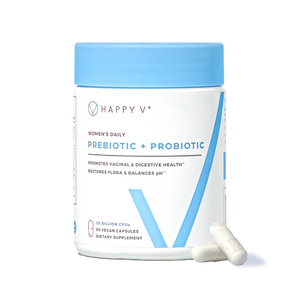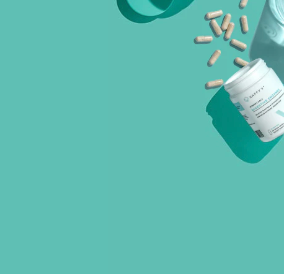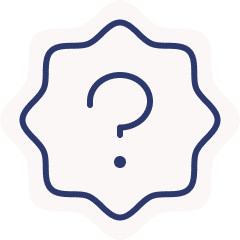- Fact Checked
- September 04, 2025
- 11 min read
Ovarian Cyst Symptoms: An FAQ Guide for Women’s Health
Table of Contents
Table of Contents
We know the words ovarian cysts can sound intimidating. You hear “cyst” and your mind immediately jumps to scary worst-case scenarios. But here’s the truth: most cysts are harmless, noncancerous, and part of how the ovary works during the menstrual cycle. Still, some do cause pain, bloating, or even fertility struggles. And because symptoms overlap with conditions like endometriosis, PCOS, or even ovarian cancer, it’s important to understand what’s happening inside your body.
This guide walks you through the most common questions women ask about cysts, including what they are, how they show up, what to watch for, and how to prevent them.
This post is for informational purposes only and does not constitute medical advice. See full disclaimer below.
What Are Ovarian Cysts?
Ovarian cysts are fluid-filled sacs that form on or inside an ovary1. They’re extremely common during the reproductive years and often appear as part of the menstrual cycle. Here’s how they develop:
- Each month, a follicle grows in the ovary, preparing to release an egg during ovulation2.
- If that follicle doesn’t release the egg or doesn’t shrink afterward, it can fill with fluid, creating a functional ovarian cyst.
By the Numbers
Ovarian cysts are far more common than most people realize. In fact:
- 14–18% of women of reproductive age will have a detectable ovarian cyst on ultrasound at any given time.
- 5–10% of women will undergo surgery to remove a cyst in their lifetime.
- Around 14% of postmenopausal women may develop ovarian cysts, though in this group, they’re monitored more closely due to a higher risk of ovarian cancer.
So while cysts are part of the natural rhythm of the female reproductive system, not all cysts are created equal. Some are harmless, others problematic. How can you tell? Keep reading!
Do Different Types of Ovarian Cysts Cause Different Symptoms?
Yes. While some cysts never cause problems, different types of ovarian cysts can produce distinct symptoms. Here’s a breakdown of the most common types of cysts, their size, and their common symptoms.
| Type of Ovarian Cyst | Typical Size | Common Symptoms | Notes |
| Functional ovarian cysts (follicular cysts, corpus luteum cysts) | Small to medium; usually <5 cm | Mild pelvic pain, cycle irregularities, sometimes bloating | Most resolve on their own within weeks; related to the menstrual cycle |
| Dermoid cysts | Can grow large (up to several cm) | Often silent until bigger; may cause abdominal pain or pressure | Contain tissue from germ cells; usually benign but may require removal if large |
| Cystadenomas | May become large cysts (5–15+ cm) | Bloating, frequent urination, painful bowel movements | Form from ovarian tissue; can stretch the ovary and press on nearby organs |
| Endometriomas (linked to endometriosis) | Small to medium; may grow over time | Severe period pain, infertility, sharp pain during sex | Caused by endometrial tissue growing on the ovary; often recur without treatment |
Of course, you won’t be able to diagnose which kind of cyst you’re experiencing (or even if you have one!) from a chart. The best thing you can do is track your pain symptoms and share them with your gynecologist during an appointment.
What are the Common Symptoms of an Ovarian Cyst?
Not all ovarian cysts announce themselves. Some come and go without you ever knowing. But when they do cause issues, the signs can range from subtle discomfort to pain that stops you in your tracks. Recognizing these symptoms early is key to knowing when to watch and wait versus when to call your health care provider.
Common symptoms of an ovarian cyst (when they exist) include:
- Pelvic pain
- Abdominal pain or bloating
- Irregular periods or bleeding between periods
- Painful sex
- Pain with bowel movements.
- Breast tenderness
- Frequent urination
- Nausea, vomiting, or dizziness
- Difficulty getting pregnant
While small cysts are generally harmless and cause mild pain (if any), any sudden or severe pelvic pain should be looked at immediately. This could indicate a cyst rupture, which may warrant some medical intervention.
What are the Risk Factors for Ovarian Cysts?
While ovarian cysts can happen to almost anyone with ovaries, certain factors make them more likely. Some risks are tied to your age and hormones, while others come from underlying conditions or past medical history.
Women with the highest risk of developing ovarian cysts are those who:
- Are in their reproductive years (before menopause)4.
- Use fertility medicines that stimulate ovulation.
- Have a history of endometriosis or PCOS.
- Have experienced a pelvic infection that spread to the ovaries or fallopian tubes.
- Have had previous ovarian cysts.
- Are postmenopausal, where cysts may signal a higher likelihood of ovarian cancer.
Understanding your risk factors can guide smarter decisions about prevention, checkups, and long-term women’s health.
How do Ovarian Cysts Differ from Other Conditions?
One of the trickiest things about ovarian cysts is that their symptoms overlap with other reproductive health conditions. Bloating, pelvic pain, and irregular cycles can just as easily point to PCOS, endometriosis, or, in rarer cases, ovarian cancer5. That’s why cysts are often confused with these conditions, and why proper diagnosis in gynecology matters so much.
Here’s how cysts stack up against other conditions they’re commonly mistaken for:
| Condition | Main Features | Common Symptoms | Key Differences |
| Ovarian Cysts | Fluid-filled sacs on or inside the ovary | Pelvic pain, abdominal pain, bloating, irregular cycles | Often resolve naturally; risk of rupture or ovarian torsion |
| PCOS | Multiple small cysts + hormone imbalance | Irregular cycles, acne, infertility | Chronic endocrine disorder, not just isolated cysts |
| Endometriosis | Tissue outside uterus; may form endometriomas | Severe pain, painful periods, infertility | Pain tied to the menstrual cycle; cysts often recur |
| Ovarian Cancer | Malignant ovarian tumors | Persistent bloating, fullness, urinary/bowel changes | More common in postmenopausal women; requires urgent oncology care |
Because these conditions can look so similar, it’s not uncommon for women to go years without a clear answer. A cyst that feels like endometriosis, or bloating mistaken for ovarian cancer, can delay the right treatment. That’s why pelvic ultrasound, blood tests, and laparoscopy play such a crucial role in distinguishing cysts from other causes of pelvic pain and ensuring the right care plan is in place.
How are Ovarian Cysts Diagnosed?
Because cysts can mimic other conditions, getting the right diagnosis is essential. Most of the time, the process is straightforward. Your health care provider will start with a basic exam and, if needed, use imaging or lab tests to learn more. These tools not only identify the cyst but also help rule out more serious concerns like ovarian cancer.
Diagnosis usually starts with a pelvic exam, followed by imaging tests or labs, which may include pelvic or transvaginal ultrasounds and blood tests. In rare cases, your doctor may also want to perform an MRI or CT scan. These help them get a better view of large or complex cysts.
Your doctor may ask to perform a pregnancy test to exclude pregnancy-related cysts.
What Complications Can Ovarian Cysts Cause?
Most ovarian cysts are harmless and resolve on their own without issue. Some of the possible complications when it comes to cysts include:
Ovarian Torsion
This is where the cyst twists the ovary, cutting off blood flow. This is a true medical emergency and generally causes sudden, intense pain, nausea, and vomiting. Ovarian torsion accounts for 1-15% of ER visits for women in acute pain, and surgery is required to fix it.
Cyst Rupture
If a cysts burst (especially a large one), it can trigger intense pain, internal bleeding, or an infection. Any sudden pain, especially one that does not resolve after drinking and resting, should be seen by a doctor.
Fertility Challenges
Chronic or large cysts, especially those tied to endometriosis, can interfere with ovulation or damage the reproductive system. If you have been struggling to get pregnant, it's worth asking your doctor if you can check for cysts.
What Treatment Options Are Available?
For the most part, ovarian cysts don't require any form of treatment. They simply shrink and disappear within a matter of weeks. But if cysts cause symptoms, grow larger, or look suspicious on an ultrasound, your doctor may recommend certain forms of medical or surgical intervention. These often include:
Follow-up ultrasounds
Your doctor may ask to do more imaging in a few weeks or a month to check on the cyst to see if it is shrinking, growing larger, or staying the same.
Birth control pills
Hormonal birth control pills can regulate the menstrual cycle and reduce the risk of new cysts forming.
Pain management
If cysts are causing severe abdominal or pelvic pain, your doctor may suggest over-the-counter or prescription medications to provide relief.
Surgery
There are several types of surgery that can be performed for a cyst. Your doctor can recommend removing only the cyst itself, which is called a cystectomy. In cases where a cyst is complex or linked to cancer, your doctor may recommend an oophorectomy or salpingo-oophorectomy, which is the removal of one or both ovaries, sometimes with the fallopian tubes. Rest assured, though, this is rare. Most women with cysts recover fully, without any kind of surgical intervention, and go on to have healthy, long-term ovarian function.
Can Ovarian Cysts be Prevented?
No. Not every ovarian cyst can be prevented. But you can lower your risk by creating an environment where your hormones, menstrual cycle, and ovaries function as smoothly and pain-free as possible. How: Here are a few evidence-based ways (because you know we love the evidence):
Use Hormonal Birth Control
Hormonal birth control prevents pregnancy by suppressing ovulation, which also lowers the chance of developing functional ovarian cysts. It's worth discussing and exploring with your doctor if you have a history of recurring cysts.
Get Regular Pelvic Exams
Routine pelvic exams give your health care provider the chance to spot cysts (and a lot of other issues!) before they cause pain or complications.
Manage Underlying Conditions
Conditions like endometriosis and PCOS increase the risk of cysts. Managing these conditions can reduce cyst formation while improving your overall health.
Make Healthy Lifestyle Choices
Your hormones aren't just driven by your menstrual cycle. They're also impacted by exercise, nutrition, and stress levels. Living well and maintaining a healthy weight reduces not only the risk of ovarian cysts but also other reproductive and metabolic issues.
Use Science-Supported Supplements
Certain supplements may help promote hormone balance and support ovarian function. Happy V's Ovarian Support is doctor-formulated with clinically studied ingredients like:
-
Myo-inositol – helps regulate ovulation and support cycle regularity.
-
DIM (Diindolylmethane) – supports healthy estrogen metabolism.
-
Vitamin D3 – plays a role in hormone regulation and ovarian health.
- Zinc – supports reproductive wellness and hormone balance.
Together, these nutrients are designed to ease bloating, support a healthy menstrual cycle, and give your ovaries the foundation they need for long-term balance. While no supplement can cure cysts, adding targeted support can be an important part of a proactive prevention strategy.
When Should I See a Health Care Provider?
Most ovarian cysts resolve without any noticeable symptoms, but as with anything, there are exceptions that warrant immediate medical attention.
Seek immediate care if you experience:
- Sudden, severe pelvic pain
- Nausea, vomiting, or dizziness alongside pain
- Signs of internal bleeding, such as fainting, weakness, or lightheadedness
If you're experiencing these symptoms and your doctor is closed or unavailable for a same-day appointment, head to the ER.
Final Thoughts
Ovarian cysts are a natural part of life for many women. While most are noncancerous and resolve on their own, some can cause significant symptoms or complications, especially when it comes to fertility and overall women's health. Understanding the different types of ovarian cysts, knowing your risk factors, and staying on top of routine exams are the best ways to protect your ovaries, now and for the long term.
Keep the Conversation Going
- Visit our blog for more women’s health tips.
- Join our private Happy V Facebook group to hear from others who’ve been there.
- Explore supplements designed to support your vaginal health journey.
Disclaimer: This blog is for informational and educational purposes only and is not intended to diagnose, treat, cure, or prevent any disease. Statements about supplements have not been evaluated by the Food and Drug Administration. For more information about vaginal infections, visit the CDC or speak to a licensed healthcare provider.












